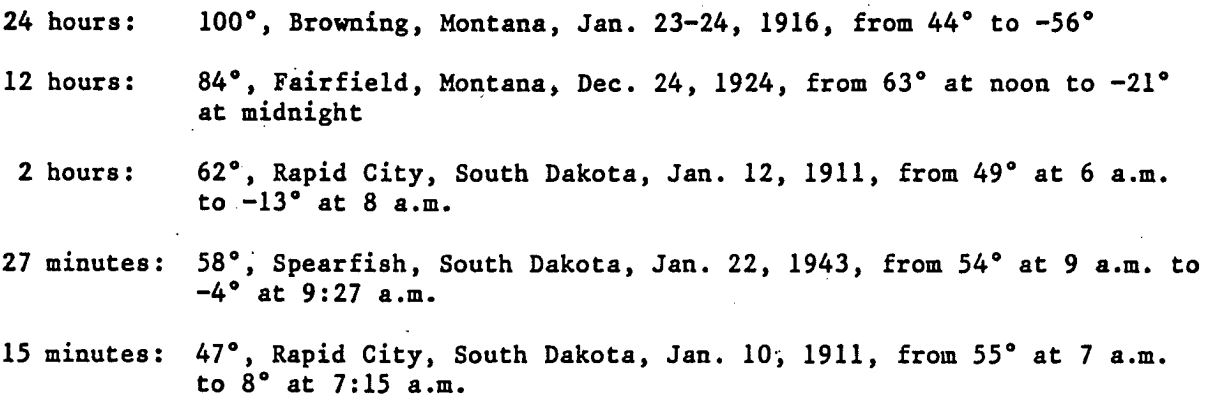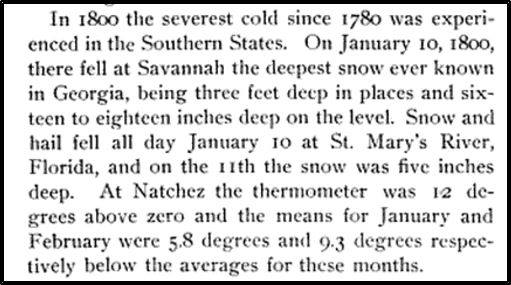Weather History - January 10th
Local and Regional Events:
January 10, 1911:
The temperature at Rapid City, South Dakota, plunged 47 degrees in just fifteen minutes. At 7 AM, the temperature was 55 degrees. Fifteen minutes later, it was 4 degrees below zero.

The information above is from the Environmental Information Summaries (C-5) on Temperature Extremes in the United States.
January 10, 1975:
An intense area of low pressure moved from eastern Iowa through eastern Minnesota. The storm center set many low-pressure records as it moved across eastern Minnesota. New snow of 3 to 6 inches across much of Minnesota began to blow and drift on the morning of the 10th and then developed into a full-blown blizzard with heavy snowfall developing. The blizzard continued through the 11th with winds of 30 to 50 mph with gusts of 60 to 80 mph. Drifts up to 20 feet high in west-central Minnesota paralyzed the area. Snowfall amounts from 1 to 2 feet occurred. Numerous roads were closed due to drifting and low visibility. Numerous sustained power outages occurred, particularly in rural sections. Thousands of people were stranded, with 168 people trapped in a train in Willmar. Wind chills ranged from 50 below to 80 below the storm. Extensive losses to life and property occurred. There were 35 deaths during the storm and many injuries. Tens of thousands of livestock and poultry losses also occurred, with 140 farm buildings damaged or destroyed. Losses to livestock and property were over 20 million. It took 11 days to clear some areas.
In South Dakota, snow began to fall on the 10th in the afternoon, and then the winds increased and reached blizzard conditions by evening. These severe blizzard conditions continued through the 11th and the morning of the 12th. Wind chills fell to 50 below to 70 below zero. Many cars stalled on roads due to poor visibility, icy roads, and blowing and drifting snow. Eight people lost their lives. Thousands of livestock and poultry were lost. During the blizzard, a 2000 foot radio and TV antenna just east of Sioux Falls collapsed.
January 10, 2000:
High winds gusting to over 60 mph caused some spotty damage across central and north-central South Dakota. Near Mobridge, the high winds blew a semi-tractor-trailer off the road and tipped it over while heading westbound on Highway 12. The semi-tractor-trailer sustained quite a bit of damage as a result. The high winds also damaged the windmill at the museum in Mobridge, breaking off the tail and bending several blades. Some high wind reports include; 56 mph at McLaughlin, 58 mph at Onida and Mobridge, and 63 mph at Pierre.
U.S.A and Global Events for January 10th:
1800: According to David Ludlum, Savannah, Georgia, received a foot and a half of snow and ten inches blanketed Charleston, SC. It was the heaviest snowfall of record for the immediate Coastal Plain of the southeastern U.S.

The image above is from the "Memorial History of Louisville from Its First Settlement to the Year 1896." Pg. 24. Click HERE to read the book.
1949: Snow was reported in San Diego, California, for the first time since 1882. The snow was noted on some of the beaches in parts of the Los Angeles metropolitan area. Click HERE for photographs. Click HERE for more information from scvhistory.com.
1973: A powerful F5 tornado struck San Justo, a town in the province of Santa Fe, Argentina, on January 10, 1973. At least 63 people were reported dead, and 350 were reported injured as it cut a 300-yard wide swath through the town. Click HERE for more information.
1982: Bitterly cold weather was found across Illinois. Of the 109 weather reporting stations in the state, 48 of those reported lows of 20 degrees below zero or colder. Some of the most frigid temperatures included 27 below zero at Rockford, 26 below zero at Chicago, and 25 below zero at Kankakee and Peoria. The Freezer Bowl was played between the Cincinnati Bengals and the San Deigo Chargers in bitterly cold wind chills. The air temperature was −9 °F, but the wind chill, factoring in a sustained wind of 27 mph, was −37 °F. Click HERE for more information from Cincinnati.com
Click HERE for more This Day in Weather History from the Southeast Regional Climate Center.